Cornus facts for kids
Quick facts for kids Cornus |
|
|---|---|
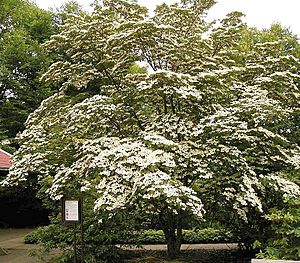 |
|
| Cornus kousa var. chinensis | |
| Scientific classification |
|
| Kingdom: | Plantae |
| Clade: | Tracheophytes |
| Clade: | Angiosperms |
| Clade: | Eudicots |
| Clade: | Asterids |
| Order: | Cornales |
| Family: | Cornaceae |
| Genus: | Cornus L. |
| Type species | |
| Cornus mas |
|
| Subgenera | |
|
|
| Synonyms | |
|
Chamaepericlimenum Hill |
|
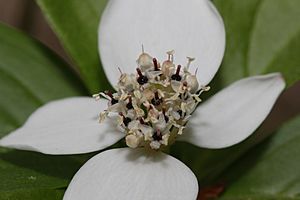
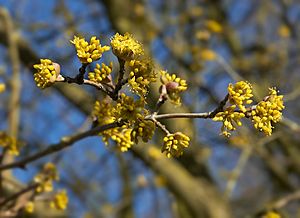
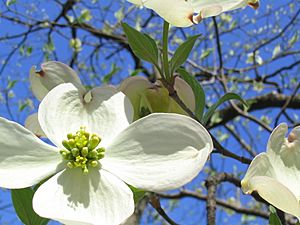

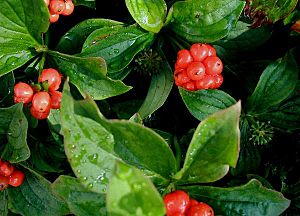
Cornus is a group of about 30 to 60 different kinds of woody plants. They are commonly known as dogwoods. You can usually tell them apart by their unique flowers, berries, and bark.
Most dogwoods are deciduous trees or shrubs. This means they lose their leaves in the fall. A few types are small, low-growing plants. Some woody species are evergreen, keeping their leaves all year.
Many dogwood species have small flowers. These flowers are often surrounded by large, white, petal-like leaves called bracts. Other types have more open groups of flowers with regular petals.
Dogwoods grow naturally in many parts of the world. They are found in temperate and boreal areas. This includes much of Europe, Asia, and North America. China, Japan, and the southeastern United States have many native dogwood species.
Some well-known dogwood species include the common dogwood of Europe and Asia. There's also the popular flowering dogwood from eastern North America. The Kousa dogwood comes from eastern Asia. Two small, low-growing types are the Canadian and Eurasian dwarf cornels. These are also called bunchberries.
Scientists group dogwoods in different ways. Some divide them into many smaller groups. But usually, they are all placed in the single large group called Cornus.
Contents
What Does "Dogwood" Mean?
The name "dog-tree" was first used before 1548. It changed to "dogwood" by 1614. Once the name stuck, these trees were sometimes called "Hound's Tree." Their fruits were known as "dogberries" or "houndberries."
Another idea is that "dogwood" came from an old English word, dagwood. This word might have referred to using the tree's very hard wood. People used it to make sharp objects like daggers, skewers, or arrows.
An even older name for the dogwood in English was "whipple-tree." This name was used by Geoffrey Chaucer in his famous book, The Canterbury Tales. A whippletree is also a part of old horse-drawn carts. It connects the cart to the horses' harnesses. These parts were often made from dogwood.
Features of Dogwood Trees
Dogwood trees have simple leaves that are not toothed. Their veins curve in a special way towards the leaf edges. Most dogwood types have leaves that grow opposite each other on the stem. But a few, like Cornus alternifolia, have leaves that grow alternately.
Dogwood flowers have four parts. In many species, the flowers grow in open clusters. But in others, like the flowering dogwood, the actual flowers are tiny and grouped tightly. These small flowers are surrounded by four to six large, white, petal-like bracts. These bracts are what most people think of as the "flowers."
The fruits of all dogwood species are drupes. These are fruits with one or two seeds inside, like a cherry. They are often very colorful. The fruits of some dogwood types, like those in the Cornus subgenus, are safe to eat. Many don't have much flavor.
However, Cornus kousa and Cornus mas are sold as edible fruit trees. Cornus kousa fruits taste sweet and tropical, like pudding. They have hard pits inside. Cornus mas fruits are both tart and sweet when fully ripe. People in Eastern Europe have eaten them for centuries. They are used as food and as medicine for colds and flu. They are also very high in vitamin C.
But the fruits of other dogwood types, like those in the Swida subgenus, are a bit toxic to people. Birds, however, eat them easily.
Dogwoods are also a food source for the larvae (caterpillars) of some butterflies and moths. These include the emperor moth and the small angle shades.
How People Use Dogwoods
Dogwood trees are very popular for planting in gardens. Their strong, dense wood is also useful for special purposes. For example, people make cutting boards and other carved items from this beautiful wood. More than 32 kinds of game birds, like quail, eat the red seeds.
Growing Dogwoods in Gardens
Many types of Cornus, especially the flowering dogwood, are common in American gardens. A famous garden expert, Donald Wyman, once said, "There is a dogwood for almost every part of the U.S." This shows how widely they can grow.
In England, however, Cornus florida doesn't flower as well. This is because England doesn't have very cold winters or hot summers.
Other dogwood species are stoloniferous shrubs. This means they spread by sending out new shoots. They grow naturally in wet places and along rivers. Some of these are planted along highways and in natural areas. They are chosen for their bright red or yellow stems, which look great in winter. An example is Cornus sericea.
Some special types of dogwood, called cultivars, have won awards for being great garden plants. These include 'Eddie’s White Wonder' and 'Norman Hadden'.
Eating Dogwood Fruits
The Cornus mas species is often grown in southeastern Europe. It's grown for its bright, edible berries. These berries are the color of a red gemstone called carnelian. Cornelian-cherries have one seed each. People use them to make syrups and preserves.
Using Dogwood Wood
Dogwood wood is very dense and fine-grained. It has a density of 0.79. This wood is highly valued for making things that need to be very hard and strong. These include loom shuttles, tool handles, and roller skates.
Even though it's tough to work with, some artists like dogwood for small projects. They make walking canes, arrows, and musical instruments like mountain dulcimers. It's also used for beautiful inlays in furniture. Dogwood wood is a great replacement for persimmon wood in the heads of some golf clubs. It's hard to find dogwood lumber from stores. People usually have to cut it down themselves.
Sometimes, larger items are made from dogwood. These include screw-in basket-style presses for wine or fruit. The first laminated tennis rackets were also made from thin strips of this wood.
Early American pioneers used dogwood twigs to brush their teeth. They would peel off the bark, bite the twig, and then scrub their teeth.
Dogwood in Traditional Medicine
The bark of Cornus species has a lot of tannins. These are natural plant compounds. In traditional medicine, the bark was used as a substitute for quinine. Quinine is a medicine used to treat fevers.
During the American Civil War, Confederate soldiers made a tea from the bark. They used it to treat pain and fevers. They also used dogwood leaves in a poultice. A poultice is a soft, moist mass applied to the body to relieve soreness. They used it to cover wounds.
The Japanese cornel, Cornus officinalis, is widely used in traditional Chinese medicine. It's known as shān zhū yú and is used for several minor health problems.
Types of Dogwood Plants
Scientists usually group all dogwoods into one large genus called Cornus. Within this genus, there are four main subgroups and ten smaller subgenera. These groups are based on how the plants are related. Dogwoods grow naturally in certain areas. Sometimes, cultivated species spread beyond their native homes, but they rarely become invasive.
Here are some of the main types of dogwoods:
Blue or White-Fruited Dogwoods
These dogwoods have small, non-showy flowers. Their fruits are round and can be white, blue, or black.
- Subgenus Yinquania
- Cornus oblonga
- Cornus peruviana (found from Costa Rica to Bolivia)
- Subgenus Kraniopsis
- Cornus alba (Siberian dogwood)
- Cornus amomum (silky dogwood)
- Cornus drummondii (roughleaf dogwood)
- Cornus sanguinea (common dogwood)
- Cornus sericea (red osier dogwood)
- Subgenus Mesomora
- Cornus alternifolia (pagoda dogwood)
- Cornus controversa (table dogwood)
Cornelian Cherries
These dogwoods have small flowers. Their fruits are oblong and red.
- Subgenus Cornus
- Cornus mas (European cornel or Cornelian-cherry)
- Cornus officinalis (Japanese cornel)
- Subgenus Sinocornus
- Cornus chinensis (Chinese cornel)
Big-Bracted Dogwoods
These dogwoods have large, petal-like bracts around their flowers. Their fruits are usually red.
- Subgenus Cynoxylon
- Cornus florida (flowering dogwood)
- Cornus nuttallii (Pacific dogwood)
- Subgenus Syncarpea
- Cornus capitata (Himalayan flowering dogwood)
- Cornus kousa (Kousa dogwood)
Dwarf Dogwoods
These are small, low-growing plants. They have four petal-like bracts and round, red fruits. They spread underground using rhizomes.
- Subgenus Arctocrania
- Cornus canadensis (Canadian dwarf cornel or bunchberry)
- Cornus suecica (Eurasian dwarf cornel or bunchberry)
Garden Hybrids
Some dogwoods are created by crossing different species in gardens.
- Cornus × rutgersensis (a mix of C. florida and C. kousa)
Where the Name Comes From
The name Cornus is an old Latin word. It refers to the Cornelian cherry, Cornus mas. The word 'Cornus' means 'horn'. This might be because the wood is very hard, like a horn.
See also
 In Spanish: Cornus para niños
In Spanish: Cornus para niños




